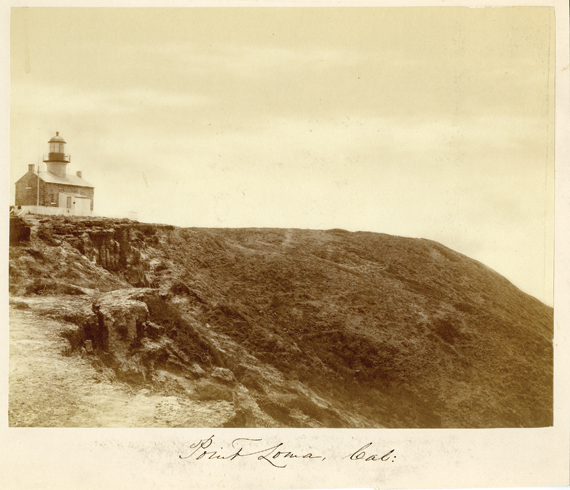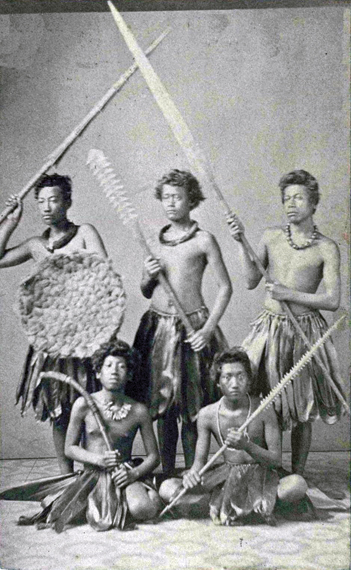|
The Hawaiian Connection
By Alexander D. Bevil
Did you know that Hawaiian music and language could be heard on Point Loma centuries before the area's current Tiki-themed restaurants and resort hotels?
In Two Years before the Mast, maritime author Richard Henry Dana, Jr., who visited San Diego while a seaman on board the Pilgrim from 1835 to 1836, wrote that "there was a considerable colony of them [Hawaiian-speakers] at La Playa."
San Diego's deep-water anchorage from 1769 to 1870, there were about 800 men of many nationalities at La Playa during the time of Dana's visit. Ocean-going vessels anchored offshore would unload cow hides collected up and down the California coast onto the beach. Part of Dana's duties was to clean, cure, and store cow hides in one of La Playa's barn-like hide houses. Once enough cured hides were gathered, he would then have to help haul them back down to the beach where they were once again loaded onto waiting ships, which would carry them to distant ports to be transformed into leather goods. It was during his stay at San Diego's Hide Park, that Dana met and befriended a number of Kanakas.

Point Loma and the 1855 lighthouse, 1871
Instead of using the proper plural spelling, Kanaka, Dana wrote Kanakas to describe all "Sandwich Islanders . . . over the Pacific Ocean.") Often used derisively against native Hawaiians by whites, or haoles, Kanaka means human being in Native Hawaiian. Today Kanaka Maoli means Native Hawaiians; persons who can trace their ancestry back to the islands' indigenous people prior to European contact. For the sake of clarity, this article will refer to them as Hawaiians.
Although British explorer Captain James Cook is credited with having discovered the islands in 1778 and named them after the Earl of Sandwich, Polynesian seafarers had already made the discovery over 2,000 years "B.C." ("Before Cook"). Excellent mariners, the Hawaiians would serve on board American and English ships in the trade between the Hawaiian Islands and California. Like other sailors in-between cruises, they would camp and work at beachside hide houses owned and operated by foreign shipping companies.
Practically adopted by the La Playan Hawaiians, Dana described the twenty or so as "the most interesting, intelligent, and kind-hearted people that I ever fell in with. I felt a positive attachment for almost all of them; and many of them I have, to this time, a feeling for, which would lead me to go a great way for the mere pleasure of seeing them, and which will always make me feel a strong interest in the mere name of a Sandwich Islander."
As a student of Hawaiian culture and language, I was interested in Dana's description of his friends' singing while working.
That which strikes a stranger most peculiarly is their style of singing. They run on in a low, gutteral monotonous sort of chant ... their sounds apparently modulated solely in the throat. They sing about persons and things which are around them, and are not understood by any but themselves.

Group of Hawaiian warriors dressed in native costume, c. 1860, carte de visite by Henry L. Chase. There are no photos or sketches of the Kanaka in San Diego, but this is a fair representation of what they would have looked like. They were apparently gone by 1859, when Richard Henry Dana came back for a visit.
One of the chants Dana may have heard was I Ku Mau Mau, a stanza of which is:
I ku mau mau, I ku huluhulu, I ka lanawao
"Stand together, haul with all your might under the mighty trees."
This ancient chant, which was originally sung by Native Hawaiians hauling the great koa tree logs down from the mountains for canoes or heiau idols, was a call for the joining together of people for a single purpose: such as hauling piles of heavy cowhides from ship to shore and vice-versa. The chant is still sung today by Kanaka Maoli at work, sporting events, or protesting Native Rights violations.
The former site of the original La Playa landing place is no longer extant; absorbed by the grounds of U.S. Naval Base Point Loma.
However, the site is listed as a City of San Diego and California State Landmark as San Diego's first historic deep-water port. I hope that you agree that it should also be recognized for its historical association with San Diego's ethnic Hawaiian community; the most interesting, intelligent, and kind-hearted people that I have ever met.
|
MORE FROM THIS ISSUE
From the Editor
Warner-Carrillo Ranch House
Santa Ysabel General Store
The Hawaiian Connection
San Diego's First Chinese
Community
Temple Beth Israel
Archaeological Myth Busting
Chicano Park & its Wondrous Murals
Sleeping Porches & Suffragist
Banners
Most Endangered List of
Historic Resources
Windemere Cottage
People In Preservation Winners
In Memoriam
Preservation Community
Recent Acquisitions
Save Balboa Park
Lost San Diego
Strength in Numbers
Donations 2010-2011
Advertisements
DOWNLOAD full magazine as pdf (11.3mb)
|





